
Sata-Pitaka Series

29 books









The book is a study of the inscriptions produced during the Classic Age of Central Java to examine the historical evolution of the civilisation there during the eighth and ninth centuries AD. The focus is on the flowering of Mahayana Buddhism in the region under the royal patronage of the Shailendra dynasty. Attempting a systematic and comprehensive review of the Sanskrit inscriptions attributed to the monarchs of the dynasty, it shows that they provide a wealth ...

This is a study of different aspects of Buddhism in the course of its evolution and decline in the Indian subcontinent, China, Japan and South-east Asia. Using comparative archaeological observations of the Buddhist cosmopolis to explain regional variations in Buddhist iconography and culture, internalisation and innovation in Buddhist art, mandalas of Vairocana and Trika Shaivism of Kashmir, it showcases the development and qualitative changes in iconography ...

The volume presents an annotated translation in English of the Tibetan critical edition of Tsong kha pa’s commentary, blo-gsal bgrod-pa’i them-skas, on the different types of noble beings that progress towards awakening. The commentary by Tsong kha pa (fourteenth-fifteenth centuries), recognised as one of the masters of Tibetan Buddhism, offers an exegesis of the characteristics and attainments that noble beings (those of the Buddhist samgha who ...

This book is a survey of Buddhist art, literature, monasteries and general history of Mongolian lands, the transcreation of the 6000 plus works in the Kanjur and Tanjur, highlights of Lamaism across the centuries, the writing of 220 philosophical, ritual, hagiographical and historical works under the Manchu dynasty, and so on. The development continued till 1920s when the communists took over. It also relates the destruction of 750 large monasteries uprooted down ...

Buddhism in Kashmir has the contributions of sixteen professors from India, Hongkong, Moscow, Berlin, Kathmandu and Bangkok. It details the work of Kashmiri masters in the transmission of sutras to China, the legendary visit of Lao-tzu to Kashmir, the role of Kashmiri teachers in Khotan and Tibet, the articulation of Vaibhasika doctrines by Sanghabhadra in a Chinese translation by Xuan zang, Buddhist terracottas, stupas and monastery in Ambaran Jammu deification ...

A fundamental work for the philosophic and artistic understanding of the theory and graphic representation of the mandalas in general and especially in the Shingon tradition of Japan. Details the philosophy, patriarchs and sacred canon of Mantrayana, its ulterior development into two branches in Japan, the nature and different kinds of mandalas, as well as their classification and essential principles. The twin mandalas of Vairocana based on the ...

This volume provides the first critical edition and complete Western translation of an influential apotropaic scripture of Mahayana Vajrayana Buddhism, The Great Amulet, Great Queen of Spells (Mahapratisara-Mahavidyarajni). This piece of the dharani literature from around the middle of the first millennium became a member of the popular Pancaraksa collection and has remained in use in Nepal up to the present time.
After an introduction, editions of the five ...

This book covers the great academic exchange that took place between Indian monks and Chinese intellectuals during the first millennium of the Christian era. Information on Sanskrit linguistics transmitted by Indian monks helped Chinese intellectuals to evolve a phonetic system to read their pictographic script. It solved one of their greatest eadaches. Introduction of the theories of Sanskrit prosody led to the innovation of a totally new genre of poems that ...

This work is a collection of essays published in honour of Lokesh Chandra, a renowned scholar of Tibetan, Mongolian and Sino-Japanese Buddhism.;;Following a biographical sketch of Prof. Chandra by his niece ManjuShree, the book offers a varied range of papers written by scholars who are all known for their contributions to the study of ancient Indian cultural influences abroad, particularly in insular and mainland Southeast Asia.

The book begins with the sunyata of Bamiyan, discusses its international nexus, the tragic history of its destruction where Hazara tribals once lit an occasional lamp to the glory of their ancestors, its influence on the Buddhist sculptural tradition, the failure of all efforts to prevent iconoclasm, or the positive comment of an Afghan: 'interest in Afghanistan's past gives hope for Afghanistan's future'. The arise of a colossal Maitreya at ...

This volume contains the minor writings of Prof. Lokesh Chandra on Buddhism, the role of women therein, and the opening up of the vast Buddhist literature in the Tibetan Canon. He goes on to a personal narrative of his sinological studies, followed by identification of the votive banners of Tun-huang and the Karma-vibhanga. Culture and civilization as interactive diversities in the Sino-Indian context, the lives of early Buddhist masters in the catalogue of ...

This book by Margit Koves details the history of Turks in Central Asia from their first Empire on the Orkhon River from 546 to 658 AD, and the subsequent Uigur States in Kocho, Bisbalyq, East Turkestan and Kansu. It describes the origin and development of the Uigur language, and the formation of written Uigur literature from the oral tradition. The main thrust of the work is the place of the Golden Light Sutra (Suvarna-prabhasa-sutra) in Uigur literature, its ...

The Dictionary of Buddhist Iconography is an endeavour of half a century to identify, classify, describe and delineate the bewildering variation in Buddhist icons. It spans the last twenty centuries, and it is a comparative study of unprecedented geographic variations, besides the ever evolving visualisations of great masters who introduced extraordinary plurality of divine forms in the dharanis and sadhanas. The Dictionary details the characteristic attributes, ...

Moments of contemplation find expression in iconography. As the vision becomes vaster and cosmic moments of transcendence involve form, the inner universe works itself into art. The other shore, the insight becomes, rtambhara (Yogasutras 1.48). Living experience flows into the rhapsodic form, an access to the yonder mind of inspiration. The iconic forms are a search of the overflowing of the depths wherein images unify and perfect. This second volume of the ...

The Dictionary of Buddhist Iconography is an endeavour of half a century to identify, classify, describe and delineate the bewildering variation in Buddhist icons. It spans the last twenty centuries, and it is a comparative study of unprecedented geographic variations, besides the ever evolving visualizations of great masters who introduced extraordinary plurality of divine forms in the dharanis and sadhanas. The multiple forms of a theonym arise in varying ...

The Dictionary of Buddhist Iconography is an endeavour of half a century to identify, classify, describe and delineate the bewildering variation in Buddhist icons. It spans the last twenty centuries, and it is a comparative study of unprecedented geographic variations, besides the ever-evolving visualizations of great masters who introduced extraordinary plurality of divine forms in the dharanis and sadhanas. The multiple forms of a theonym arise in varying ...

The Dictionary of Buddhist Iconography is an endeavour of half a century to identify, classify, describe and delineate the bewildering variation in Buddhist icons. It spans the last twenty centuries, and it is a comparative study of unprecedented geographic variations, besides the ever-evolving visualizations of great masters who introduced extraordinary plurality of divine forms in the dharanis and sadhanas. The multiple forms of a theonym arise in varying ...

The Dictionary of Buddhist Iconography is an endeavour of half a century to identify, classify, describe and delineate the bewildering variation in Buddhist icons. It spans the last twenty centuries, and it is a comparative study of unprecedented geographic variations, besides the ever-evolving visualizations of great masters who introduced extraordinary plurality of divine forms in the dharanis and sadhanas. The multiple forms of a theonym arise in varying ...

The Dictionary of Buddhist Iconography is an endeavour of half a century to identify, classify, describe and delineate the bewildering variation in Buddhist icons. It spans the last twenty centuries, and it is a comparative study of unprecedented geographic variations, besides the ever-evolving visualizations of great masters who introduced extraordinary plurality of divine forms in the dharanis and sadhanas. The multiple forms of a theonym arise in varying ...

The Dictionary of Budddhist Iconography is an endeavour of half a century to identify, classify, describe and delineate the bewildering variation in Buddhist Icons. It spans the last twenty centuries, and it is a comparative study of unprecedented geographric variations, besides the ever-evolving visalisations of great masters who introduced extraordinary plurality of divine forms in the dharanis and sadhanas. The multiple forms of a theonym arise in varying ...

The dictionary of Buddhist Iconography is an endeavour of half a century to identify, classify, describe and delineate the bewildering variation in Buddhist icons. It spans the last twenty centuries, and it is a comparative study of unprecedented geographic variations, besides the ever-evolving visualizations of great masters who introduced extraordinary plurality of divine forms in the dharanis and sadhanas. The multiple forms of a theonym arise in varying ...

The Dictionary of Buddhist Iconography is an endeavour of half a century to identify, classify, describe and delineate the bewildering variation in Buddhist icons. It spans the last twenty centuries, and it is a comparative study of unprecedented geographic variations, besides the ever-evolving visualizations of great masters who introduced extraordinary plurality of divine forms in the dharanis and sadhansas. The multiple forms of a theonym arise in varying ...

The dictionary of Buddhist Iconography is an endeavour of half a century to identify, classify, describe and delineate the bewildering variation in Buddhist icons. It spans the last twenty centuries, and it is a comparative study of unprecedented geographic variations, besides the ever-evolving visualizations of great masters who introduced extraordinary plurality of divine forms in the dharanis and sadhanas. The multiple forms of a theonym arise in varying ...
